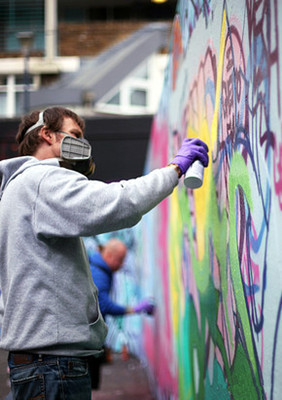涂鴉
The writing's on the wall
墻上文化
Having turned respectable, graffiti culture is dying
涂鴉文化獲得體面,然瀕臨滅絕
LONDON'S fastest-changing art gallery is hidden in a sunken ball court on a housing estate in Stockwell, southLondon. On a sunny Sunday afternoon six or seven men, mostly in their 30s, are busy painting the walls with new designs. They have put up cartoons, names written in elaborate, multicoloured lettering and clever perspective tricks. Tins of spray paint and beer stand on the ground; ladders lean against the paintings. The atmosphere is not unlike that of a golf course: a mix of concentration and blokey relaxation.
倫敦的藝術展瞬息萬變,這次則在倫敦南部斯托克維爾住宅區的一個地下球場舉行。一個陽光明媚的周日午后,六七個30多歲的男子把自己的新設計畫在墻壁上。他們在上面畫了卡通圖,精心設計的名字、色彩繽紛的字母和巧妙的錯覺圖。地上擺著一瓶瓶噴漆和啤酒,扶梯靠在墻上。這場景和高爾夫球場一樣:是一種專注力和娛樂休閑的并存體。

Graffiti painting is traditionally a daredevil pursuit. Teenagers dodge security guards to put their names on trains and buses. But over the past decade that has all but disappeared fromBritain's cities. Between 2007 and 2012 the number of incidents of graffiti recorded by the British Transport Police fell by 63%. A survey by the environment ministry shows that fewer places are blighted by tags than ever. Graffiti are increasingly confined to sanctioned walls, such as the Stockwell ball courts. In time the practice may die out entirely.
一般來講,涂鴉畫可謂是一種不計后果的活動。年輕人們會避開保安,把它們的名字畫上火車和巴士。但在過去的十年,這種現象在英國的城市已經消失了。從2007到2012年,違反英國交通法規的涂鴉案件下降了63%。環境部的調查顯示,比起以前,受到標語破壞的地方越來越少。現在,涂鴉畫日益局限在那些允許被涂畫的墻上,比如斯托克維爾的球場。假以時日,這種行為可能會完全消亡。
The most obvious reason for the decline in tagging and train-painting is better policing, says Keegan Webb, who runs The London Vandal, a graffiti blog. Numerous CCTV cameras mean it is harder to get away with painting illegally. And punishments are more severe. Once-prolific taggers such as Daniel Halpin, who painted his pseudonym “Tox” all overLondon, have been given long prison sentences. British graffiti artists who want to paint trains usually go abroad to do it these days, says Mr Webb.
Keegan Webb,一個經營名叫“倫敦文化藝術破壞者”的涂鴉博客的博主說,繪名和鐵皮車涂鴉風靡程度下降最主要的原因是政策法規更加完備。非法在墻上繪圖越來越難以逃離無處不在的中央電視臺攝像頭,相應的懲罰也更加嚴重了。多產的繪名藝人Daniel Halpin把他的筆名“Tox”涂遍了整個倫敦,因此被判長期監禁。Mr Webb說近來想去涂畫鐵皮火車的英國的涂鴉藝人通常都會選擇出國。
A generational shift is apparent, too. Fewer teenagers are getting into painting walls. They prefer to play with iPads and video games, reckons Boyd Hill, an artist known as Solo One, who in effect runs the Stockwell ball courts. Those who do get involved tend to prefer street art to graffiti proper (which purists define as letters and names, however elaborately drawn). Some have gone to art school and want to make money from their paintings. The internet means that painters can win far more attention by posting pictures online than they can by breaking into a railway yard.
一代人心態的轉變也很明顯。現在越來越少的年輕人想參與墻上涂鴉活動。經營斯托克維爾球場的Boyd Hill(被稱為藝術家獨一人)承認,相較而言,年輕人們更愿意玩兒IPad和電腦游戲。就算對這方面感興趣的年輕人也比較喜歡街頭藝術,而非正宗的涂鴉(不管畫得多么仔細,純粹主義者們都只稱其為字母和名字)。他們中有一些人已經去了藝術學校,并想從他們的繪畫作品中獲利。網絡的普及意味著這些人可以把自己的繪圖在線上傳,相較把它們畫在鐵路調車場,這樣更能提高他們的知名度。
Taggers and graffiti artists mostly grew up in the 1980s and 1990s. Those men—and almost all are men—are now older and less willing to take risks. “We can't run away from the police any more,” says Ben Eine, who turned from tagging to street art. The hip-hop culture that inspired graffiti in the first place has faded. Video games and comic books provide more inspiration than music.
繪名和涂鴉藝人大都是80或90后。這個群體—大多是男士—礙于年齡,不甚愿意冒險。Ben Eine說“無論如何我們再也不能像從前那樣從警察眼皮子下溜走了。”,因而他從“繪名黨”轉向街頭藝術。剛開始掀起涂鴉的嘻哈文化已漸漸銷聲匿跡。相比較而言,電子游戲和漫畫書比音樂更能予人靈感。
Graffiti may eventually disappear. But for now the hobby is almost respectable. Mr Eine says he has lots of friends who used to paint trains. Now with wives and children, they paint abandoned warehouses at the weekend. It has become something to do on a Sunday afternoon—a slightly healthier alternative to sitting watching the football
涂鴉畫可能最終會消失。但是直至現在,這種愛好仍然受到人們的尊敬。Ben Eine說他有很多朋友曾經癡迷于在火車車皮廂上作畫。現在有了妻兒,他們只有周末去廢棄的倉庫墻上大展身手。這已經成了周日下午的慣例—一種比坐在電視機前看足球略微健康的消遣。譯者:張丹 校對:尤熠












